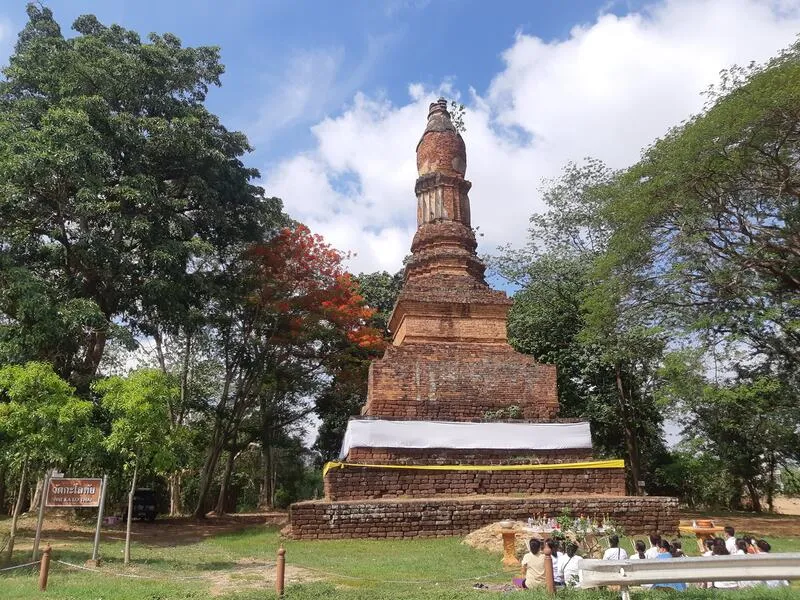
Rating: 3.6/5 (5 votes)
Kamphaeng Phet attractions
Attractions in Thailand
Opening days: Daily
Opening hours: 08.00 - 17.00
Wat Kalothai in Kamphaeng Phet Province is an ancient temple with significant historical, religious, and cultural importance. The temple was established during the Sukhothai period, around the same time as the construction of Nakhon Chum city, which was one of the key centers of the Sukhothai Kingdom. Wat Kalothai was not only a place for religious ceremonies but also played a historical role, as it once served as a temporary residence for Ayutthaya kings during military campaigns to the northern cities. This site reflects the importance of geography and religion as a center for community life and governance in ancient times.
The temple is especially notable for its unique architecture, particularly the lotus bud-shaped chedi, also known as the "pum khao bint" style, which is characteristic of prominent Sukhothai-era temples, such as Wat Chedi Klang Thung and Wat Wang Phra That. The chedi features a square base and intricate patterns that demonstrate artistic refinement and reflect Buddhist beliefs and devotion. The design emphasizes balance, serenity, and simplicity, which are key characteristics of Sukhothai art, valuing natural beauty and graceful elegance.
Within the temple complex, other historical structures such as the old temple walls, the sermon hall, and traditional ceremonial buildings can be found. These elements provide important evidence of the religious and cultural prosperity of the Sukhothai community. The design and layout of the temple reflect the lifestyle and beliefs of people at the time and highlight the skills of local artisans and architects specializing in ancient Thai temple construction.
Wat Kalothai holds considerable historical significance because during the Ayutthaya period, it was used as a temporary residence by kings and their military when traveling to northern cities. The use of the temple as a royal resting place demonstrates the strategic and cultural importance of the location. In addition, the temple has long been a center for the local community and Buddhist devotees, serving as a venue for religious ceremonies and cultural activities throughout the year. Visiting Wat Kalothai today allows travelers not only to admire the historical architecture but also to gain a deep understanding of Thai history and culture.
Visitors are particularly drawn to the lotus bud-shaped chedi, the temple's iconic feature, which symbolizes the beauty of Sukhothai art. Photography of the chedi and its detailed patterns is very popular. Moreover, guests can explore the surrounding temple grounds to learn about other historical structures and experience the peaceful atmosphere that preserves the temple's original character.
Preservation of Wat Kalothai is crucial to safeguarding Thailand’s artistic and cultural heritage. Government cultural agencies and local communities work together to maintain the chedi, historical structures, and other buildings within the temple, ensuring they remain intact for study and education. Preservation efforts extend beyond structural restoration to include the revival of traditional ceremonies and rituals associated with the temple, such as almsgiving, candlelight processions, and religious festivals. These practices help Wat Kalothai continue to serve as a community center and a valuable site for learning about Thai culture today.
Wat Kalothai represents a prime example of a Sukhothai-era temple, reflecting religious prosperity, architectural elegance, and historical importance. Despite renovations over time, the chedi’s lotus bud shape and intricate artistic patterns still evoke a sense of serenity, devotion, and appreciation for ancient Thai culture. Visiting the temple offers not only a chance to explore a historically significant site but also an opportunity to understand the lifestyle, beliefs, and traditions of ancient Thai communities up close.
Today, Wat Kalothai remains a key cultural and historical tourism destination in Kamphaeng Phet Province. Visitors can explore the chedi, historical structures, and surrounding grounds to study Sukhothai architecture and art in depth. Traveling to the temple provides a cultural tourism experience while fostering a deeper understanding of Thai history and supporting the preservation of cultural heritage for future generations.
Comment
| Keyword (Advance) |
 Region
Region
|

 Category:
Category:  Group:
Group: